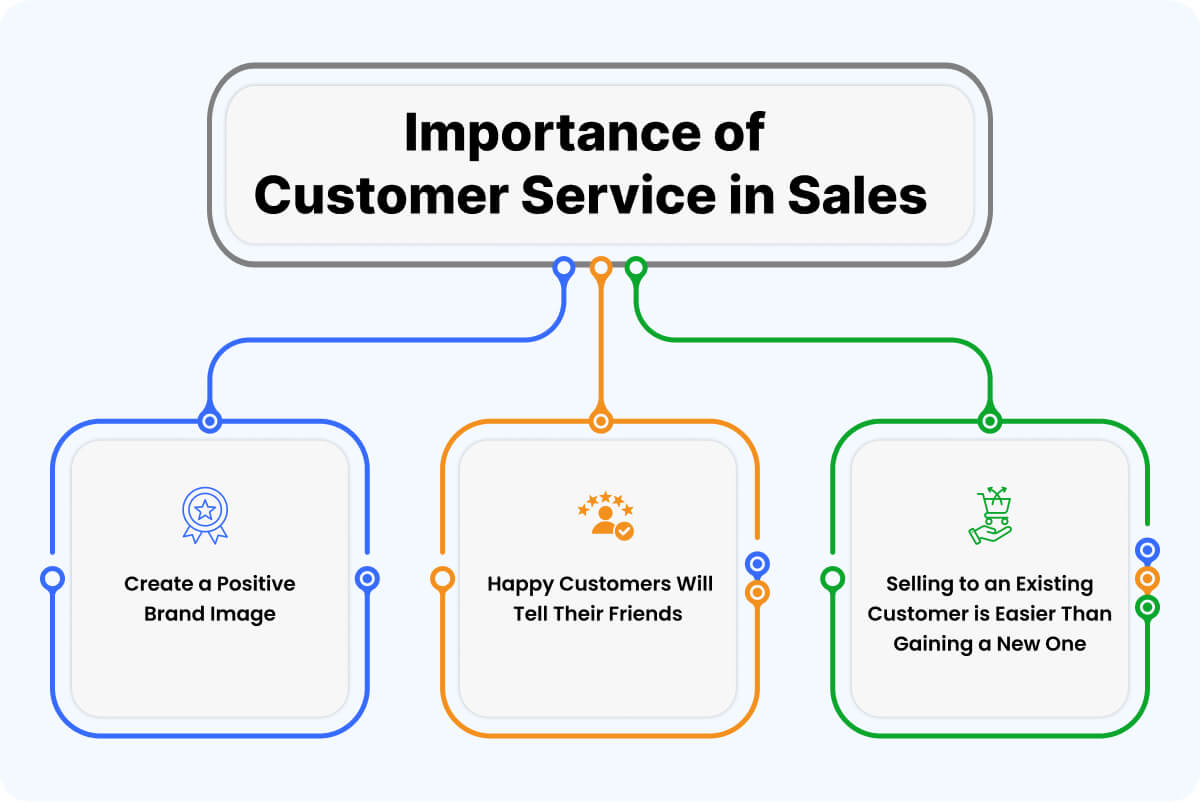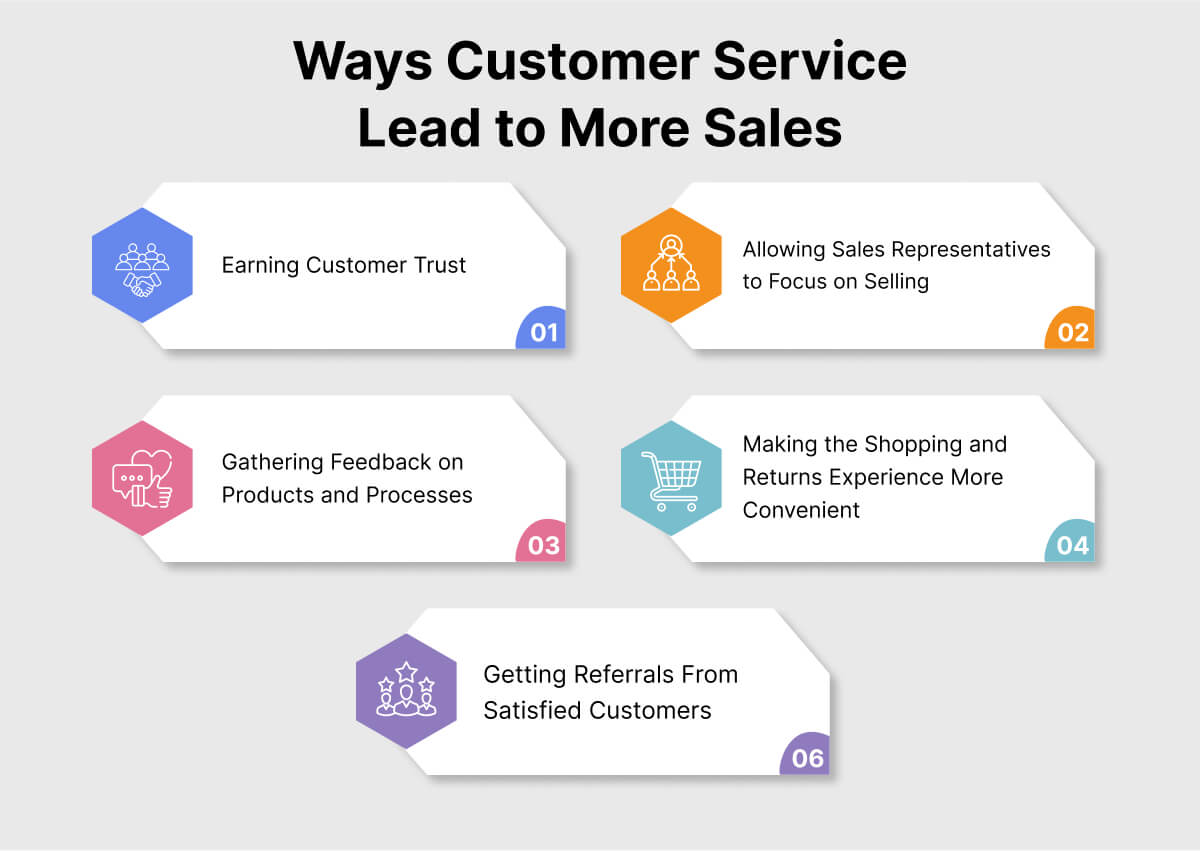How Great Customer Service Equals Explosive Sales Growth?
- August 14, 2023
- 11 mins read
- Listen

Table of Content
Customer service is not just a support function but a dynamic force that propels sales to new heights. In the labyrinth of modern commerce, where choices abound and consumer empowerment reigns, businesses that recognize the profound connection between customer service and sales stand poised to conquer the market.
In this article, we’ll unravel the symbiotic relationship between customer service and sales, uncovering how this dynamic duo can transform mere transactions into thriving partnerships and elevate your brand to unprecedented success.
So let’s explore customer service to sales key components, key differences, and importance.
What is Customer Service?
Customer service refers to the assistance and support provided by a business or organization to its customers before, during, and after the purchase of a product or service. It encompasses a range of activities and interactions aimed at ensuring customer satisfaction, building positive relationships, and addressing customer needs and concerns.
Effective customer service is crucial for maintaining a loyal customer base, enhancing brand reputation, and driving business growth.
Let’s take a closer look at the key components of customer service:
- Communication: Promptly responding to customer inquiries, questions, and concerns through various channels such as phone, email, live chat, social media, and in-person interactions.
- Problem Resolution: Identifying and resolving issues, complaints, or challenges faced by customers in a timely and satisfactory manner.
- Product Knowledge: Having a deep understanding of the products or services offered, so that customer inquiries can be answered accurately and comprehensively.
- Personalization: Tailoring interactions and solutions to meet individual customer needs and preferences, creating a personalized experience.
- Empathy: You need to show genuine concern and understanding for customers’ emotions, frustrations, and concerns. You can take a look at these positive empathy statements to treat them with respect and empathy.
- Accessibility: Making it easy for customers to reach out for help and support, providing multiple contact options, and ensuring user-friendly interfaces.
- Feedback and Improvement: Collecting and analyzing customer feedback to identify areas for improvement and enhance the overall customer experience.
- Training: Providing ongoing training and support to customer service representatives to ensure they have the necessary skills and knowledge to assist customers effectively.
- Consistency: Delivering a consistent level of service across different touchpoints and interactions, maintaining a uniform brand image.
- Proactive Engagement: Anticipating and addressing potential issues before they escalate, offering assistance and guidance to customers even before they ask for help.
- Building Relationships: Fostering positive, long-term relationships with customers to encourage repeat business and word-of-mouth referrals.
Undoubtedly, positive customer experiences can lead to increased customer retention, higher sales, and a stronger market position, while poor customer service can lead to negative reviews, customer churn, and damage to the brand’s reputation.
As a result, many businesses invest time and resources in developing and maintaining effective customer service strategies and practices.
Key Difference Between Sales and Customer Service
Sales and customer service are both crucial components of a business, each with its distinct focus and responsibilities.
Here are the key differences between the two:
Primary Goal
- Sales: The primary goal of sales is to generate revenue by promoting and selling products or services to customers. Sales teams aim to close deals and meet or exceed sales targets.
- Customer Service: The primary goal of customer service is to ensure customer satisfaction and retention. Customer service teams focus on addressing customer inquiries, resolving issues, and providing support to enhance the overall customer experience.
Nature of Interaction
- Sales: Sales interactions are often proactive and persuasive. Sales professionals engage with potential customers to present products or services, highlight their benefits, and persuade customers to make a purchase.
- Customer Service: Customer service interactions are reactive and focused on addressing customer needs.
Timeline
- Sales: Sales interactions typically revolve around closing a deal within a relatively short timeframe. The sales process involves lead generation, prospecting, presenting offers, and closing sales.
- Customer Service: Customer service interactions can occur before, during, and after a purchase. They focus on building long-term relationships, addressing concerns, and ensuring ongoing customer satisfaction.
Responsibility
- Sales: Sales teams are responsible for identifying potential customers, building relationships, negotiating terms, and finalizing transactions.
- Customer Service: Customer service teams are responsible for resolving issues, providing support, offering product information, and ensuring that customers have a positive experience with the company.
Metrics
- Sales: Sales performance is often measured using metrics such as revenue generated, sales quotas achieved, conversion rates, and average deal size.
- Customer Service: Customer service performance is measured through metrics like customer satisfaction scores, response and resolution times, customer retention rates, and feedback from customers.
Focus on Revenue
- Sales: The main focus is on driving revenue and generating profits for the company.
- Customer Service: While customer service contributes to customer retention and repeat business, its main focus is on providing exceptional support and maintaining a positive customer relationship.
Sales and customer service serve distinct but complementary roles within a business. Sales teams drive revenue by acquiring new customers, while customer service teams ensure customer satisfaction and loyalty by providing excellent support and assistance.
What is the Importance of Customer Service in Sales?
Customer service plays a pivotal role in the realm of sales, offering substantial benefits that can significantly impact a company’s success.
Let’s see the importance of customer service in sales by exploring key points backed by data:
1. Create a Positive Brand Image
Exceptional customer service contributes to building a positive brand image, which is crucial for sustained business growth. According to a study by American Express, 90% of Americans consider customer service as a factor in deciding whether or not to do business with a company.
A seamless and satisfying customer experience establishes trust and loyalty, enhancing the likelihood of repeat business and referrals.
Additionally, a positive brand image can mitigate the impact of negative feedback or occasional mistakes, as customers are more forgiving when they have a strong relationship with a brand.
2. Happy Customers Will Tell Their Friends
Word-of-mouth marketing remains one of the most effective forms of promotion. Happy customers are more likely to share their positive experiences with friends, family, and colleagues. Thereby, expanding your brand’s reach without additional marketing efforts.
A study by Nielsen revealed that 92% of consumers trust recommendations from friends and family over other forms of advertising. This organic referral network can significantly impact your sales, as potential customers tend to rely on personal recommendations when making purchasing decisions.
3. Selling to an Existing Customer is Easier Than Gaining a New One
Data consistently highlights the cost-effectiveness of selling to existing customers compared to acquiring new ones. According to research conducted by Invesp, the probability of selling to an existing customer is 60-70%, while the possibility of selling to a new prospect is just 5-20%. Existing customers are already familiar with your brand, products, and services, reducing the need for extensive marketing and sales efforts. Additionally, loyal customers tend to spend more over time, further boosting your revenue and profitability.
Undeniably, customer service is an essential component of successful sales strategies. It not only helps create a positive brand image but also leverages the power of word-of-mouth marketing and capitalizes on the cost-effectiveness of selling to existing customers.
By prioritizing exceptional customer service, businesses can foster long-term relationships, increase customer retention, and ultimately drive sustainable sales growth.
How Can Customer Service Lead to More Sales?
Customer service directly and profoundly impacts driving more sales for a business. By prioritizing customer satisfaction and building strong relationships, customer service can become a powerful driver of increased revenue.
Here’s a detailed look at how customer service can lead to more sales, supported by relevant data:
1. Earning Customer Trust
Trust is a cornerstone of successful sales. When customers trust a brand, they are more likely to make purchases and become repeat buyers. According to the Edelman Trust Barometer, 81% of consumers say that trust in a brand influences their purchasing decisions.
Exceptional customer service, characterized by prompt and accurate responses, problem resolution, and transparency, fosters trust and cultivates a positive perception of the brand. This trust translates into higher sales as customers feel more confident about purchasing.
Pro Tips
- Provide timely and personalized responses to customer inquiries, showing that you value their time and concerns.
- Train customer service agents to be knowledgeable about your products or services, so they can provide accurate information and solutions.
- Be transparent about product availability, pricing, and any potential delays.
- Address customer complaints or issues promptly and professionally to demonstrate your commitment to customer satisfaction.
2. Allowing Sales Representatives to Focus on Selling
Efficient customer service can free up sales representatives to focus on their core responsibilities: selling.
When customer inquiries, issues, and support are handled effectively by a dedicated customer service team, sales reps can devote more time to engaging with leads and closing deals. This streamlined approach improves sales efficiency and enhances the customer experience.
According to Salesforce, 67% of customers and 74% of business buyers expect companies to offer real-time interactions.
Pro Tips
- Implement self-service options such as FAQs, knowledge bases, and chatbots to handle routine inquiries, freeing up sales reps’ time.
- Develop a clear division of responsibilities between customer service and sales teams to avoid duplication of efforts.
- Use customer relationship management (CRM) software to track customer interactions and ensure seamless communication between departments.
3. Gathering Feedback on Products and Processes
Customer service interactions provide valuable insights into customer preferences, pain points, and suggestions for improvement. Actively seeking and utilizing customer feedback can lead to product enhancements and process optimizations, ultimately boosting sales.
According to a survey by Microsoft, 77% of consumers have a more favorable view of brands that proactively ask for and accept customer feedback.
Pro Tips
- Actively solicit feedback through surveys, post-purchase follow-ups, and social media channels.
- Provide incentives for customers to participate in feedback surveys, such as discounts or exclusive offers.
- Regularly analyze and categorize feedback to identify trends and areas for improvement.
- Use customer feedback to make iterative enhancements to products, services, and processes.
4. Making the Shopping and Returns Experience More Convenient
A smooth and convenient shopping experience is a significant driver of sales. Effective customer service ensures that customers have a positive experience not only during the purchase but also when returning products or resolving any issues.
A study by UPS found that 67% of online shoppers review a retailer’s return policy before making a purchase, highlighting the importance of hassle-free returns.
By providing excellent customer service throughout the buying cycle, businesses can reduce cart abandonment rates and increase sales.
Pro Tips
- Streamline the online shopping process with intuitive navigation, clear product descriptions, and easy-to-use checkout options.
- Implement a user-friendly and transparent returns policy, and communicate it prominently on your website.
- Offer multiple channels for customer support, such as live chat, email, and phone, to accommodate different preferences.
- Provide tracking information and updates for orders and returns to keep customers informed.
5. Getting Referrals From Satisfied Customers
Satisfied customers are more likely to refer friends, family, and colleagues to a brand. Customer service interactions that exceed expectations can create strong advocates who actively promote the brand to their networks.
Nielsen’s Global Trust in Advertising report revealed that 83% of consumers trust recommendations from friends and family.
By nurturing these customer relationships, businesses can tap into a powerful source of new leads and potential sales.
Pro Tips
- Encourage satisfied customers to leave reviews and testimonials on your website or third-party review platforms.
- Launch a referral program that rewards customers for referring friends or family members.
- Leverage social media and email marketing to showcase customer success stories and testimonials.
- Engage with customers on social media, responding to their comments and creating a sense of community.
Conclusion
The harmony between customer service and sales resounds as a melody of growth and prosperity. As we draw the curtain on this exploration, one thing becomes strikingly clear: customer service is the secret ingredient that infuses the art of sales with authenticity, trust, and lasting impact.
By nurturing a culture of exceptional customer care, businesses not only pave the way for increased sales but also cultivate a legacy of loyalty and advocacy.
So, let us embrace this timeless wisdom, forge unbreakable bonds with our customers, and embark on a journey where every interaction is a stepping stone toward unparalleled triumph. Remember, in the grand tapestry of business success, the thread of customer service weaves the brightest chapters of all.






